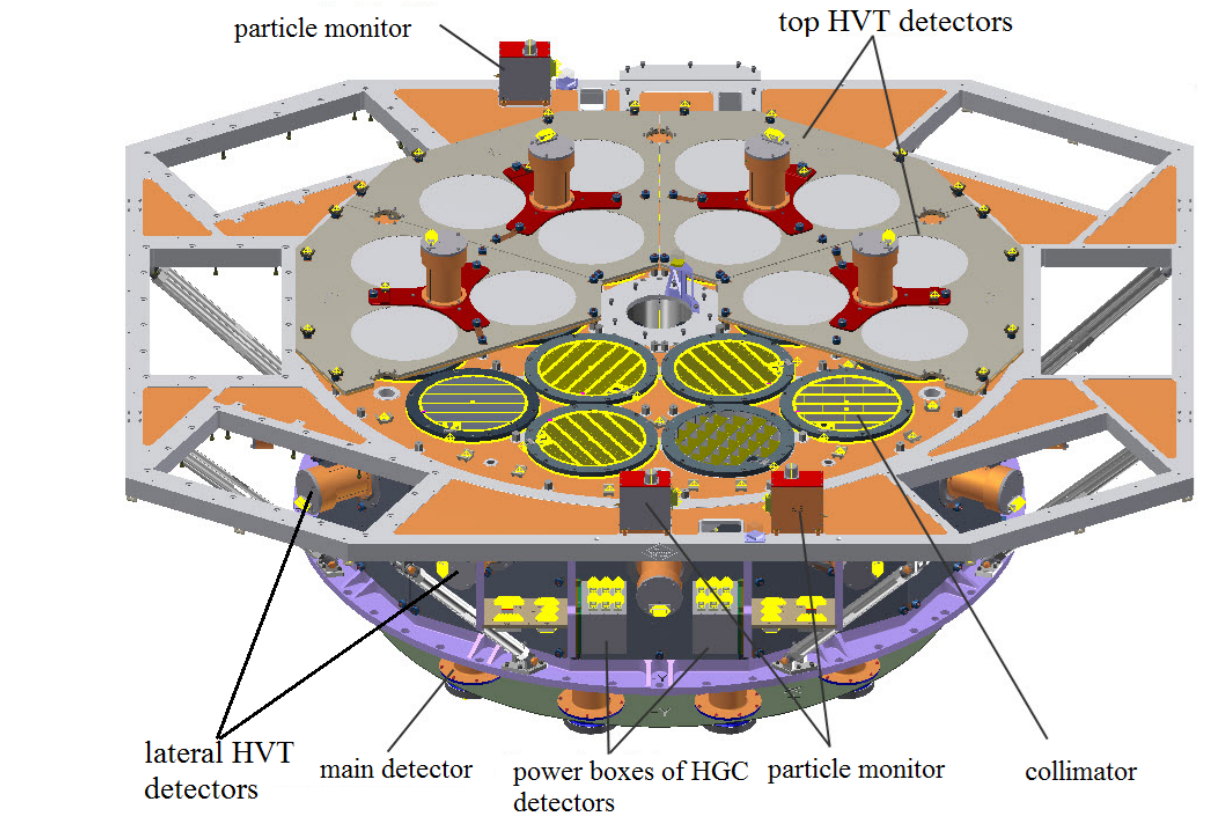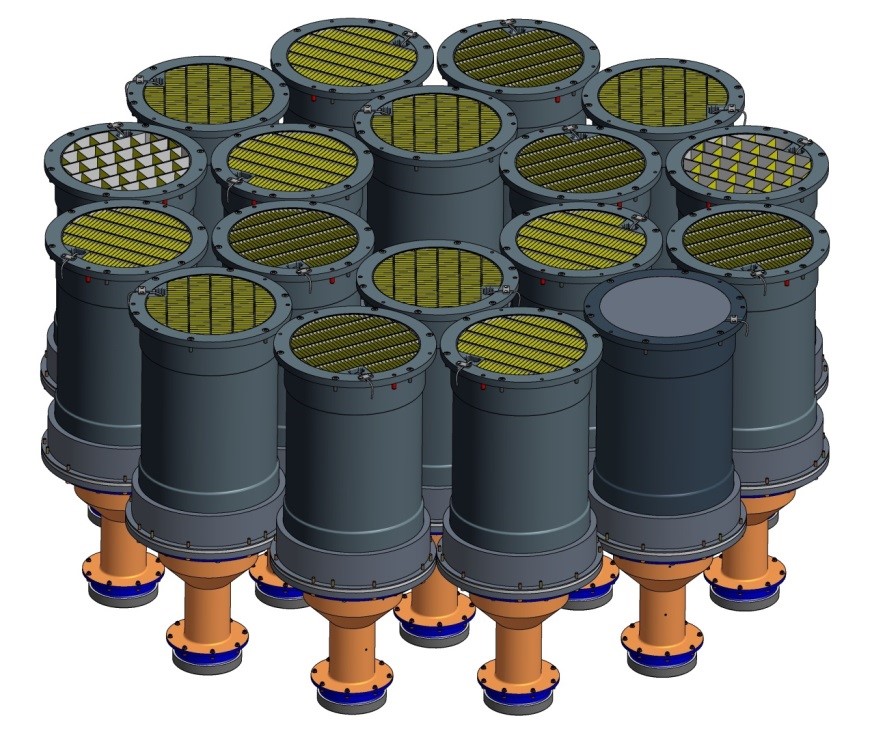High energy X-ray Telescope (HE)
The overview of Insight-HXMT/HE is taken from Liu et al (2020). HE is composed of eighteen groups of detector units. Every unit consists of a compound NaI(Tl)/CsI(Na) crystals detector and a collimator. In addition, HE contains in-orbit calibration detectors and switch boxes, anti-coincidence detectors, particle-monitors (PM) and corresponding mechanical structure, as described in Fig. 1.

Fig. 1 The lay-out of different HE units.
HE detector performs in hard X-ray band 20-250 keV. To supply space modulation for the direct demodulation imaging, the FOVs of eighteen collimators are mounted in three different directions; in-orbit calibration detectors are used for gain-control and spectral calibration; to decrease the particle background, the anti-coincidence detectors are adopted to shield the charged particles in space. The particle detectors are utilized to monitor the particle flux to protect the main detectors and anti-coincidence detectors with high voltage when the particle flux is too high.
HE detector contains 18 groups of compound crystal detector-arrays. Each detector unit is composed of a cylindrical NaI(Tl)/CsI(Na) phoswich scintillation detector with a diameter of 19 cm (i.e., geometrical area of 283.5 cm2) and the total geometrical area is 5100 cm2. Due to the photoelectric effect in the NaI(Tl), the X-ray photons could deposit energy, which is used to measure the energy spectra and arrival times of the hard X-ray events. The latter CsI(Na) is primarily used as an active shielding detector to reject background events incident from the backside within the solid angle of 2π. The scintillation signals of these two types of crystals can be read out by a shared Photomultiplier Tube (PMT) and selected by Pulse Shape Discrimination (PSD) technique for selecting good events, during which energy is deposited only in the NaI(Tl) scintillator rather than in CsI(Na). To eliminate the side-effect of the evolving temperature on the detector, HE detector adopts the active temperature-control to maintain the temperature at 18±2℃.
There are 18 collimators, designed for the 18 detectors accordingly. The FOV of 15 collimators is set to 1.1°×5.7° and two collimators are 5.7°×5.7°. Specifically, one collimator with a FOV of 1.1°×5.7° is covered by a 2 mm-thick tantalum lid, which is used to measure the local background of HE and is called a blocked detector. All the 18 collimators are divided into three groups and separated with orientation of 60° in the payload, which form the FOV of 5.7°×5.7°. The collimator allows the access of photons from special direction, rather than from other directions. The collimator is grid structure,which is made of material with strong X-ray absorption. The size of the grid determines the FOV of the collimator, e.g., the FOV of 1.1°×5.7° is made of grids with 6 mm×30 mm×300 mm (width*length*height). The distribution of 18 HE main detectors and 18 collimators is shown in Fig. 2.
The function of the in-orbit calibration detector depends on radioactive source 241Am and plastic scintillator. 241Am with radioactivity of about 200 Bq is embedded into a small plastic scintillator, which is installed in the grid, and close to the injection window of the corresponding detector. The calibration source emits the 59.5 keV photons and the 5.5 MeV α particle, which are detected by the main detector and the plastic scintillator, respectively. If these two signals are detected simultaneously, the signal is tagged as calibration events. Based on the variation of calibration events (the good events produced by the 59.5 keV photons in the detector), HE power-control box adjusts the high-voltage of the PMT of the main detector to stabilize the gain of the main detector.
The particle-monitor (PM) is used to measure the flux of the high energy protons and electrons. When the flux is higher than a critical value, the PMTs in the main detectors and the anti-coincidence detectors would be closed to protect the tubes. There are three PMs mounted in HE payload. A PM is composed of a plastic scintillator, a photomultiplier tube, a high voltage unit and electronic circuit. The plastic scintillator is designed to be a cylinder with height of 10 mm and diameter of 10 mm, whose top and side surface are painted with reflection material. The above system is packaged with Teflon, plastic hat and 1 mm aluminum sheets. The lower energy threshold of PM is 1 MeV (20 MeV) for electrons (protons). The fluorescence could be produced by the collision of the charged particles with the plastic scintillator. The fluorescence signal detected by PMT (0.5 inch) is processed in HE power-control box. HE main detector can not perform the scientific observation when the environment is filled with many charged particles (e.g., in SAA) with the protection of the PM.
Anti-coincidence detector (ACD) is embedded into the front of the main detector, and consists of 6 top detectors and 12 side-surface detectors. ACD is designed as an active veto detector, i.e., screening the background event produced by the injected charged particles within the solid angle in the main detector. The ACD output signal is processed in HE power-control box. In the good event data of each main detector, 18 digits of BOOL type strings define the signal in the 18 ACD when the event appears. We can manually choose suitable anti-coincidence events during the offline data reduction.
HE power-control box manages the signal processing and control of all detectors, and exchanges data with the data-manage system of the satellite via LVDS and 1553B. In order to assure the accuracy of times, HE power-control box receives the synchronized time signal from the satellite and 5 MHz time signal at the same time

Fig. 2 Detector arrays of HE of Insight-HXMT. The top is the collimator, the middle is the NaI(Tl)/CsI(Na) phoswich crystal, and the bottom is the PMT reading out the fluorescence produced during the interaction between X-ray photons and the crystal.
